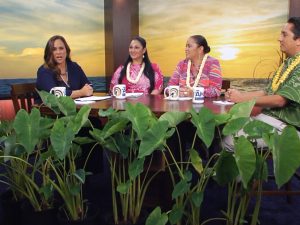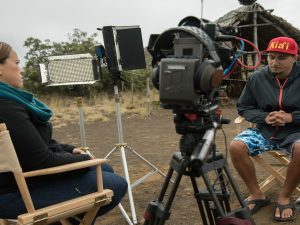While in West Hawaiʻi, Hōkūleʻa and Makaliʻi crewmembers sailed to Miloliʻi, one of the last traditional fishing villages in Hawaiʻi!
“He ʻōlelo kā kākou, ʻo ia hoʻi, he waʻa he moku, he moku he waʻa. Ma ia manaʻo, ʻike ʻia, ʻo ka waʻa, he mokupuni nō ia, aia ka ʻohana a pau, aia ka ʻai a pau, aia ka pono a pau e ola ai kākou ma ia waʻa, a pēlā pū ma ka moku. A ʻaʻohe ʻokoʻa o ka moku me ka waʻa. a no laila, no kēia holo moana ʻana o mālama honua, he pili loa i ke kipa ʻana i ia mau kaiaulu ʻoiai kū ikaika, kūpaʻa lākou i ko lākou nohona, he kupa ʻāina, he lawaʻi, he mahiʻai paha.” wahi a Lehua Wilson Ah Sam, he kanaka holokai no Makaliʻi.
Ua laha kēia ʻano nohona ma Miloliʻi, keu hoʻi ka mālama ʻia ʻana o nā hoʻoilina lawaiʻa ma o kēia kaiaulu kūʻokoʻa.
Wahi a Lei Kaupu, he wahine kupa no Miloliʻi, “aia ʻo Miloliʻi ma ka ʻaoʻao Kona Hema o Hawaiʻi Mokupuni. Nui ko mākou mahalo i ko kākou mau kūpuna no ka hoʻoili ʻana mai i ke ʻano noho kupa o ka ʻāina i kēia hanauna hou. Inā ʻaʻole no lākou, ua pau ko lākou ʻike no ka lawaiʻa a me ka mahi ʻai ʻana.”
“ʻAʻole lākou hoihoi i ka haʻalele i kekahi kaona ʻaʻole lākou hoihoi i ka noho moloā. Mea nui ke kipa mau ʻana i ia mau kaiaulu i mea, hoʻohālike paha, i mea e hōʻike aku, hōʻike mai, kōkua aku, kōkua mai kekahi.” wahi a Lehua.
Eia hou, ʻaʻole naʻe ʻo kēia ka makamua o ko ka waʻa Hōkūleʻa kipa ʻana aku iā Miloliʻi. Ma ka makahiki 1985, ua holo ʻo Hōkūleʻa mai Miloliʻi aku a hiki loa i Tahiti. ʻAʻole ʻo ia i kipa hou a i kēia wā.
Wahi a Shorty Bertleman, he kanaka hoʻokele, “ʻo ka pololei, noho mākou no kekahi mau lā, a holo aku. Akā, no ka nui aloha ma waena o mākou, ua noho mākou no kekahi mau pule.”
Wahi hou a Lei, “ma ia wā, he kamaliʻi wale nō au. ʻIke akula au iā Hōkūleʻa me ka ʻike hana kūʻokoʻa i kaʻanalike ʻia aku a kaʻanalike ʻia mai kekahi. Eia nō kā hoʻi, ʻike aku nei au i ka hānauna hou, e ʻike ana iā Hokūleʻa me ka hauʻoli, a pā ka naʻau. Ua hoʻi hou mai nō.”
A ua ʻike pū ʻia kēia manaʻo ma o kekahi o nā kānaka holokai, nāna i holo aku ma ia huakaʻi i ka makahiki 1985.
Wahi a Dennis Chun, he kanaka holokai no Hōkūleʻa, “i ka hoʻi hou ʻana mai, ʻaʻole nō i loli nui kēia wahi. Ua laha kekahi kānaka, akā mau nō ka ʻike. ʻIke leʻa ʻia ma o ka maʻemaʻe o ke kai, me ka momona o ka ʻai; mau nō ke kūʻokoʻa o ka ʻāina. A pēlā nō paha ke ʻano kūpono no kākou a pau.”
“He mea e hoʻomanaʻo iā kākou i ka pono o ke ola ma Hawaiʻi nei. He mea nui no mākou, no ka ʻohana Makaliʻi, inā ʻaʻole i loaʻa kēia ʻohana no Miloliʻi, inā ʻaʻole i loaʻa ka ʻohana ma Hoʻokena, ma Kawaihae, ma Waimea, ma Kohala, ma Hilo, ma Kaʻū ʻoe, ma.. wai lā, ʻaʻole nō kākou ola. Ma laila ko kākou ola, no laila, he mea nui no ka hoʻomau ʻana i ko kākou ola, kēia noʻonoʻo ʻo he waʻa he moku, he moku he waʻa. Pono e hoʻi a mālama i ko kākou mau ʻohana ma ʻō a ma ʻaneʻi.” i pani manaʻo ai ʻo Lehua.
ʻO wau nō ʻo Kuʻulei Bezilla e kūkala nūhou ana mai Miloliʻi aku no ʻŌiwiTV, aloha.
“A famous concept we have aboard the waʻa is that the canoe is like an island in that all of our resources are limited to what we already have. This Mālama Honua sail really highlights the different communities that we visit who share this passion of striving for self-sustainable lifestyle.” says Makaliʻi crewmember Lehua Wilson Ah Sam.
Miloliʻi is one such community that has become known for sustainable fishing.
Miloliʻi community member, Lei Kaupu, says that, “Miloliʻii is located in Kona Hema, or the south part of the big island. We mahalo our kūpuna, basically those who have already passed on and those we are grateful to have with us today. If it wasn’t for them who taught the younger generation, a lot of the practices the traditional practices of fishing, even with the māla, the ʻāina, everything would have been lost.”
“They have a simple, yet productive lifestyle. We can all look to them for collaboration as role models.” says Lehua.
This isn’t however the first time Hōkūleʻa has been to Miloliʻi. She last sailed out of here on her 1985 voyage to Tahiti.
Pwo Navigator, Shorty Bertleman, says that “we were going to come here, maybe spend a few days then take off, but it turned out we stayed here for a few weeks. So we just fell in love with the community, the community fell in love with Hōkūleʻa.”
Lei says, “I remember the last time it has been here, it docked here is when I was knee high. By seeing that and by witnessing our kupuna and having the Hōkūleʻa come, they actually taught us a lot of things to sustain ourselves and then we were able to teach them as well.”
Having our haumāna, having our kamaliʻi from Miloliʻi to be able to witness Hōkūleʻa coming in today, it was such a blessing, and you could see the excitement in their faces cause now that circle has come fully around.
This thought was also shared by 1985 crewmembers who joined on this sail.
Hōkūleʻa crewmember, Dennis Chun, says that, “coming back here and looking at it, it’s almost the same. Some of the older folks are gone, but you know, basically, it’s still the same. So I think it is important for us that we understand, I think it is viable yea. It is a viable way of life. And looking around, look at the water, it’s just pristine. And the sea life; maybe that’s the way it should be.”
“They stand as a reminder of what is important for Hawaiʻi. So it is significant to travel and visit our communities. If not for our various communities island-wide, there wouldn’t be a waʻa community. We need to take care and visit all of our communities and promote this kind of sustainable living.” says Lehua.
For more information, go to hokulea.org



